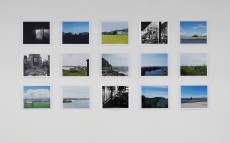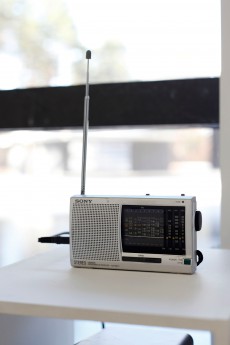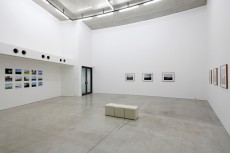
“Re-Modernologio” phase2 :Observation and Notation
October 23 (Sun) ~ December 18 (Sun), 2011 10:00 - 18:00 / Free
ASAKAI Yoko

Passage
Whereabouts of time and story
KONDO Yuki
ASAKAI Yoko’s photos convey an impression that they are illustrations for a storybook. It is because we feel as if another time would develop or another story would unfold before our eyes as we pass through the “entrance” of the framed scenes.
Asakai’s work for the residency program began with her visiting various places by car in Aomori Prefecture, where there are few high-rise buildings, and at a short distance from the city are woods, the sea and the sky stretching out. While moving around, she got interested in weather phenomena of atmospheric conditions like wind. Thus she began to move around all over Aomori Prefecture searching for “wind” to take photos of it.
Her work passage consists of photos, and composed of four elements showcased in the closed gallery space. One element is that there are eight large-sized color photographs. Each of them shows a scene in different places with a path; along the sea, in a town, in the mountains, fields, etc. in a different time zone and different weather. What is observed in common is that they are uninhabited landscapes without a person and a car, and there is an electric bulletin board at the upper left side of the road running more or less in the center in each photo. It is an anemometer to measure the velocity and direction of the wind in Aomori Prefecture, and the electric bulletin board in each of those eight photos shows the direction and velocity of the wind at the eight cardinal points respectively. Second is a group of fifteen monochrome and color photos of smaller size. Color photos depict an extensive natural spectacle in Aomori, while monochrome ones show a crowd of people in a Tokyo town surrounded by densed high buildings. In addition, as the third and fourth elements respectively, NHK[1] weather broadcast is heard in the hall, and real scenery can be overlooked from a nice large window in the hall.
All those scenes in Aomori are photographed in color. According to Asakai,[2] shooting photos of “Aomori” in black and white did not come to her mind. It is partly because there are already groups of works whose strong contrast of black and white, for example, in HOSOE Eikoh’s kamaitachi (weasel slash) and OKAMOTO Taro’s shimpi Nippon (mysterious Japan) has given a vivid impression of grudge-like feelings and customs still existing in the Tohoku district. Also, Asakai, as a person living at the present day and in a lifestyle different from the past when the above perspective was essential to view Tohoku area, probably has her eyes set on the contemporary. In any case, it seems that rather than picking up indigenous features of the local history and climate as well as the atmosphere, Asakai faces scenery and regions keeping a certain distance from them. Then, on the contrary, looking at the scenery in Tokyo, her place of residence, photographed in monochrome, we feel somehow closeness related to personal feelings and memories as the dark color is so powerful, and there are throngs of people whose faces are invisible and groups of buildings which cover the whole sky. It looks like, for instance, a mundane daily scene, which we glimpse in unfamiliar scenery, we encounter while traveling.
Such a sense of distance might have happened due to the relationship in terms of time. Asakai remarked that as the specific period of time used for the residency program was shorter than time for habitation and longer than that for traveling. That exerted some influence on her work in terms of time.[3]
This passage of time observed in her work often constitutes its features. Her most important work sight is a series, which depicts how residents of households in cities such as Berlin, Tokyo and New York are watching a movie. With household articles in the backdrop, which remind us of the passage of time in everyday life, a specific timeframe of about two hours of watching a movie is cut out. Photographed there is how those people were thoroughly immersed in the movie and their facial expressions appear to be void. We feel that we can glimpse the existence of one’s inner time, which belongs to only those who are absorbed in what they are doing, and we on this side cannot measure. As it is explained that 22930 is “an experimental series to study photos as fragments of one’s memory, which are devoid of a sequence because a house is photographed based on a certain rule,”[4] a house is used as a stage, and different times that elapse in different places in the house are showcased side by side as momentary fragments through continuous motifs as a clue. In Conversation in which researchers devoted to their work in the laboratory are photographed, a certain point in time from the past to the future is cut out, making us anticipate that there are the past time, related to experiments and precedence research, and the future time when their goal will be achieved. (Probably, in this case, due to the nature of the work, there is a feeling that the length of time could be longer, though the time is instantly cut out.) In short, the length of time that the photographed picture suggests and the flow of time cut out in the scene are different, and that difference is depicted.
Time and place are structural elements of her passage, in which wind is a common factor, and their dimensions are slightly shifted respectively. Each photo taken in Aomori showcases a recent time in the neighborhood, the weather news heard over the radio informs what is happening at a distant place in realtime, the glass window before our eyes tells us how the sky is here at this moment, and each black-and-white photo of the city depicts how the sky was at a certain moment, probably in different space at different time. On the other hand, small-sized color photos of scenery are arranged so as to put the level line of the sea or the land nearly in the same height. As the whole or the individual, the structure with a strong horizon makes us realize that the wind is blowing over the parallel space and time in a similar way, which gives the photos universality and the site anonymity. Monochrome photos of the city with a strong perpendicular structure draw attention to the difference in space and time as if a flashback of a past scene were used as an accent. Because of some editing of this kind, we come to feel a point in time in the eternal, universal flow of time. We have our time perception in a large sense receiving it as nothing special like blowing wind while we cross this universal flow at certain cross sections. Here the sensibility of Asakai as a photographer who happened to stay here at this point in time overlaps with how we are now in the universal flow of time.
In sight and Conversation, Asakai tries to capture moments when people are devoted to something or even engrossed in something forgetting themselves. However, passage has power of absorbing viewers into the scenery. Probably it depends on photographic structure and her way of display--kind of editing method. Each photo, in which an impressive stretch of empty road and an anemometer are photographed, has a strong perspective composition so that our eyes turn naturally towards the center of the sky, and further, as we focus our viewpoints on the anemometer, we are drawn into the vanishing point. On the other hand, in the color photos of scenery, in which the horizon is emphasized, there are always one or a few small human figures as seen from behind, which is different from those with an anemometer. A solitary figure placed under the vast sky could be the subject for viewers to reflect upon themselves. In the former, the viewer is drawn into the scene with his sense of reality or physical sensation through the strong centripetal force as in the composition of baroque painting, but looking at the latter, as seeing German romanticists’ landscapes, the viewer feels that only his awareness is drawn into the landscape while his body is left on this side. As we look outside at the landscape through the large glass window here at this moment, listening to the radio broadcast of the weather, which is now relevant at a far-off place, the boundary of time becomes more obscured.
Around the same time, Asakai held a solo exhibition at NADiff gallery in Tokyo, using photographs she took in Aomori. In this exhibition entitled Northerly Wind, she showcased some sentences describing weather and time from novels along with her photos. Though the sentences appear to be describing “weather” and “time” objectively, they are words that lead viewers/readers to a “created world” on the extension of the real through the medium of actual description of “weather” and “time.” What is more, by being overlapped with the inner landscape of “me,” they begin to spin another story. This is not limited to novels alone. The beginning scene of a movie showing raindrops or the sea is “language” and “image” that tell us nothing in concrete terms, but at times they tell us “something” eloquently. The same goes for photography.
Using the same materials in her exhibition in Aomori, Asakai presented the encounter with universal time in vast space/time, whereas in NADiff gallery, she confined the viewer in a specific time of the world of story by using passages from books, though there we found the same expanse. Universal time and specific time appear to form a pair of inner world and outer world. In this way, she is not simply pushing the shutter in front of a scene to convey the scene as it is. She is keenly aware of cutting-out and editing photos, and editing is the very concept of her photography. It is not only her showcasing method but also editing at the time of cutting scenes out. It might be similar to producing an image sequence or a literary style. Even if image fragments that form a story were the same, the scene and feelings that emerge would change according to the way of editing. Then, will the story change? Here the story is not always a story that we can talk about. There will be subtle differences, and because of them, it might be difficult to express the story in any means, be it words or images. That is exactly why the image fragments have potential to produce infinite stories.
[1] Japan Broadcasting Corpoeration.
[2] Interview with the artist for AC2 No. 13 (published in March 2012), regular publication by Aomori Contemporary Art Centre. Interview was conducted on December 1, 2011.
[3] Ibid.
[4] A guidebook on Asakai’s work 22930.

Passage

Passage

Passage
「再考現学 / Re-Modernologio」phase2 : 観察術と記譜法
2011年10月23日(日)~12月18日(日) 10:00 - 18:00/無料
浅海陽子
ASAKAI Yoko

《passage》
時間のありかと物語のありか
近藤由紀
朝海陽子の写真は、何か物語の挿絵のような印象も受ける。それは目の前の切り取られた場面の「入り口」を抜けた先には、別の時間と物語が広がっているように感じられるからだ。
朝海の滞在制作は、高層の建物が少なく、すこし町を離れれば森と海と広い空の広がる青森県内をひたすら車で訪ねまわるところから始まった。そうした中で朝海が気になったのは風や天気といった気象現象であった。そのため朝海は「風」を求めて県内を巡り、それらを撮影することとなった。
≪passage≫は写真作品ではあるが、閉じられたギャラリー空間に展示された4つの要素によって作品が構成されている。1つは8枚の大判のカラー写真であり、海沿い、街中、山中、田畑と様々な場所で道のある風景が、時間帯も天候もまちまちな状況で撮影されている。共通することはそこには人や車といった人影が全く見当たらないこと、そして写真のほぼ中央を通る道路の左上に細くかかる電光掲示板があることである。これらは青森県内の風を測るための風向風速計であり、8枚の写真の電光掲示板はそれぞれ八方位の地点の風向風速を示している。2つ目はそれより小さいサイズのモノクロとカラーからなる15枚の写真群である。カラー写真は青森の広々とした自然の光景が、モノクロ写真には密集した高いビルに囲まれた東京の町でひしめき合っている人々が写し出されている。ここに3つ目と4つ目の要素として会場に流れるNHKの「気象通報」のラジオ放送と広々とした大きな窓から見渡せる現実の風景が加えられている。
青森の風景は全てカラーで撮影されているが、朝海は「青森」で撮影されるこれらの作品をモノクロで撮ることは考えなかったという[1]。それは細江英公の≪鎌鼬≫や岡本太郎の「神秘日本」に代表されるモノクロの強いコントラストが東北の地に残る怨念にも似た感情や風俗を強烈に印象付けた作品群がすでに存在しているということばかりではなく、それらがその視点で東北をまなざす必要があった時代とは異なる時代、異なる時間、異なる日常に生きる朝海の現代性への志向によるのかもしれない。いずれにしても朝海の写真は、風土や土地の歴史といった土着の特質やその肌触りを拾い上げるというよりは、一定の距離をもって風景や土地に対峙しているようにみえる。そういった意味では逆にモノクロで撮影された朝海の生活の場である東京の風景は、その黒の強さ、ひしめき合う顔の見えない人々、空を覆い尽くすビル群によって、どこか私的な心情や記憶に通じる近しさが感じられ、例えば旅先で出会う非日常的な景色の間に時折顔を出す日常の一コマのようにもみえる。
こうした対象との距離感は、この場所とアーティストとの時間的関係性からうまれたものであるのかもしれない。朝海は、居住しているというには短く、旅行者よりは長いという滞在制作特有の時間が、作品にそれまでとは異なる時間を与えることとなったという[2]。
朝海の作品におけるこうした時間の流れはしばしばその作品の特徴ともなっている。朝海の代表作≪sight≫は、ベルリン、東京、ニューヨークなどの各都市の家庭でそこの住人が映画鑑賞をしている様子を撮影したシリーズ作品である。家庭の品々が想起させる日常的な時間の流れを背景に、映画という2時間前後のある特定の時間の流れが切り取られているのだが、そこでとらえられた映画の画面に没頭している人々の様子や表情はある空白のようであり、それを見るこちら側には計りしれない没入する人にのみ属する内面的な時間の存在を垣間みせる。≪22930≫は、「ある一軒の家をルールに基づき撮影することでシークエンスを欠く記憶の断片としての写真について考察する実験的シリーズ」[3]と説明されているように、一軒の家が撮影の舞台となり、連続するモチーフを手がかりにその家の様々な場所の複数の時間の流れが、ある一瞬の断片として並行して示されている。また研究室で研究に没頭する研究者を撮影したシリーズ≪Conversation≫では、「研究」という行為を通じ、実験や先行研究などの研究にまつわる過去の時間とそれが完成するであろう未来の時間を予感させることで、過去から未来へと流れるある時間の流れの中のある時間(一瞬というよりその作業の性質のせいか、切り取られた場面でありながらある程度の時間の長さを感じさせる)が切り取られている。つまりここでは撮影されたその写真の画面が示唆する時間の長さの違い、その場面がきりとった時間の流れの違いがそれぞれに示されていることがわかる。
風という共通項でくくられた≪passage≫の構成要素の時間と場所は、それぞれ少しずつ次元がずらされている。青森で撮影された写真は、この近辺の最近のある時を、ラジオから流れる気象通報はリアルタイムだがどこか遠い土地の様子を、目の前のガラス窓は今現在のこの場所の空の様子を、そしてモノクロの都会の写真は、時間も空間もおそらく異なるであろうある時の空をそれぞれ写し出している。その一方で小さいサイズのカラー写真の風景は、海や土地によって作られた水平の線がほぼ同じ高さにそろえて並べられており、その個別としても全体としても強い水平線をもつ構造が、並行した時空間に同じように吹き渡る風を感じさせ、写真に普遍性、場の匿名性を与えている。垂直線の構造が強い都会のモノクロ写真がフラッシュバックする過去の情景のように一種のアクセントとなって時空の差異を際立たせるのはそのためだろう。こうしたいくつかの装置が悠久のそして普遍の流れの中のある時点という感覚、特別なものではなく風のように受け、流れていく大きな時間感覚とそれを受け止めるある時間の交差のようなものを感じさせるのではないだろうか。それはたまたまこの期間ここに滞在したという朝海の撮影者としての感覚だけではなく、普遍的な大きな時間の流れの中に、ひととき身をおく私たち人間存在の有り様が重なる。
ところで≪sight≫、≪Conversation≫と人々が何かに没頭し、忘我さえしているような瞬間を捉えている朝海だが、この≪passage≫においては、作品をみている我々をその風景の中に没入させるような吸引力がある。それは朝海の写真の構図およびその展示の仕方—ある種の編集の仕方—によるのではないだろうか。人気のない延びる道が印象的な風向風速計が撮影された写真は、どれも空の中心に視線を向かわせる強い遠近法的構図がみられ、さらにその風向風速計に視点をあわせることで、その消失点にぐっと引き込まれていく。一方水平線を強調されたカラーの風景写真には、風向風速計の写真とは異なり後ろ姿をみせた小さな人物が1人あるいは2、3人必ず写り込んでいる。広大な空の下にぽつんと配された人物は、見る者が自身を投影させる対象となりうる。前者がバロック絵画の構図のように強い求心力によって見る者を現実感覚にあるいは身体感覚を伴って場面に引き込んでいくのに対し、後者のそれはドイツ・ロマン派の風景画を見る時のように自分の身体をこちら側においた状態で、意識だけがその風景へ吸い込まれるような感覚を覚える。そして大きな窓ガラスから臨む今ここの風景に生のままの視線で直面し、ラジオからの現在のだがどこか遠くの場所の気象情況を耳にすることで、時間の境界が一層ぼかされていくようである。
ほぼ同時期に朝海は東京のナディフ・ギャラリーにおいて青森で撮影された写真を使ってもう一つの個展を開催した。「Northerly Wind」と題されたこの展覧会で、朝海はこれらの写真とともに小説から取り出した天気や時間を示す幾つかの文章を同時に展示した。それらは客観的な描写のようにみえるが、「天候」や「時間」という現実の描写を媒介にすることで、現実の延長線上にあるものとしての「創作された世界」へと見る者/読む者を誘う言葉である。そしてまたそれは「私」の内なる風景とも重ねられることで別の物語を紡ぎ出す。おそらくそれは小説だけにとどまらない。映画の冒頭のシーンで映し出される雨の雫や海の風景は、具体的な何かを語らない「言葉」であり「イメージ」であるが、時に雄弁に「何か」を語る。そしてそれは写真も同じである。
同じ素材を使いながら、青森の展示では普遍的な時間との邂逅が広い時間と空間の中で提示されたが、ナディフの展示では同じ広がりをもちながらも小説の一節を用いることで、ある特定の物語世界の時間の中に見る者を閉じ込めていく。それは対になったインナーワールドとアウターワールドのようでもある。このように朝海の写真作品には単に目の前の光景に対してシャッターを切り、そのままの風景として提示するというのではなく、それを切り取り編集することに対する強い意識があり、その編集こそが朝海写真のコンセプトとなっている。それは展示の方法だけではなく、その場面を切り取る際の編集であり、それは映像のシークエンスの繋ぎ方、文学の文体の有り様と似ているのかもしれない。ある物語を形作るイメージの断片が同じだとしても、編集の違いにより、その場面、そこから引き出される感覚が変化していく。ではそこからつくられる物語もまた変化するのだろうか。しかしそこで作られる物語は必ずしも語ることができる物語とは限らない。そしてその差異は微細であり、微細であるがゆえに言葉でも映像でも、どんな手段においても表すことはできないのかもしれない。だからこそそれらは無限の物語を生む可能性をもつのだろう。
[1] 2011年12月1日国際芸術センター青森定期刊行誌『AC2』13号(2012年3月刊行)のためのインタビューより。
[2] 同上。
[3] 朝海陽子≪22930≫作品についてのguideより。

《passage》

《passage》

《passage》
